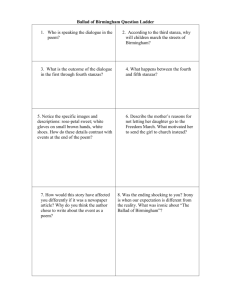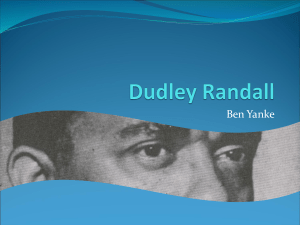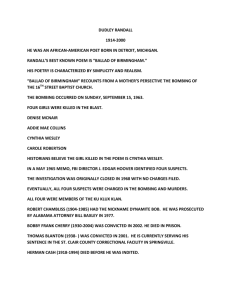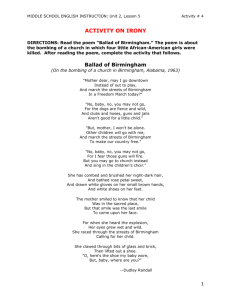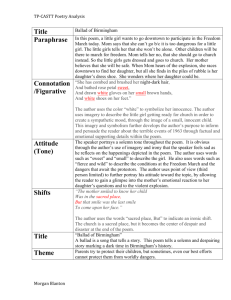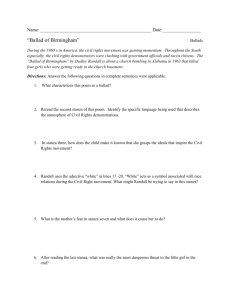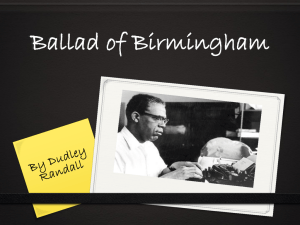dudley randall
advertisement
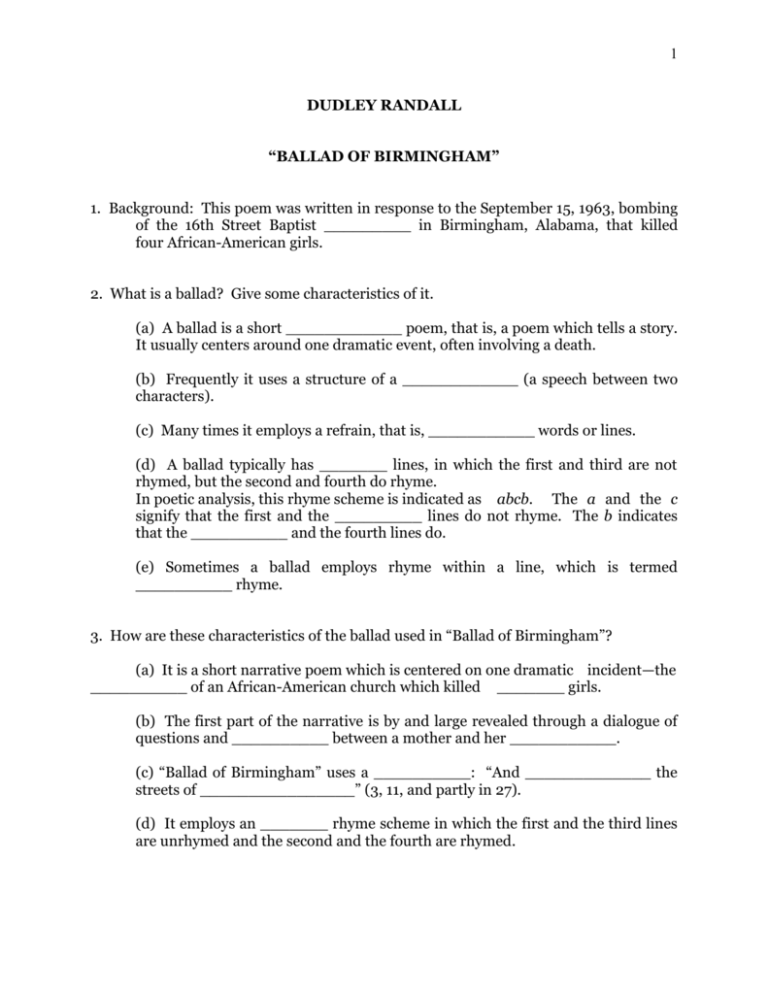
1 DUDLEY RANDALL “BALLAD OF BIRMINGHAM” 1. Background: This poem was written in response to the September 15, 1963, bombing of the 16th Street Baptist _________ in Birmingham, Alabama, that killed four African-American girls. 2. What is a ballad? Give some characteristics of it. (a) A ballad is a short ____________ poem, that is, a poem which tells a story. It usually centers around one dramatic event, often involving a death. (b) Frequently it uses a structure of a ____________ (a speech between two characters). (c) Many times it employs a refrain, that is, ___________ words or lines. (d) A ballad typically has _______ lines, in which the first and third are not rhymed, but the second and fourth do rhyme. In poetic analysis, this rhyme scheme is indicated as abcb. The a and the c signify that the first and the _________ lines do not rhyme. The b indicates that the __________ and the fourth lines do. (e) Sometimes a ballad employs rhyme within a line, which is termed __________ rhyme. 3. How are these characteristics of the ballad used in “Ballad of Birmingham”? (a) It is a short narrative poem which is centered on one dramatic incident—the __________ of an African-American church which killed _______ girls. (b) The first part of the narrative is by and large revealed through a dialogue of questions and __________ between a mother and her ___________. (c) “Ballad of Birmingham” uses a __________: “And _____________ the streets of ________________” (3, 11, and partly in 27). (d) It employs an _______ rhyme scheme in which the first and the third lines are unrhymed and the second and the fourth are rhymed. 2 (e) Internal rhyme is seen in lines 5, 13, and 21 in the words “no” and “_____” and “smiled” and “________.” 4. In literature, a protagonist is a character who wishes to do or change something. Who is the protagonist of this poem? Explain. (a) The ___________, whose race is not explicitly revealed until line 19: “And drawn ________ gloves on her small ________ hands.” (b) Despite her young age, she is committed to social responsibility. She is willing to give up time when she could be playing—“Instead of out to _________” (2)—to join in the “__________ March” (4). She says that she wants “To make our country _______” (12). 5. In literature, an antagonist is a character who opposes the goal of the protagonist. Who is the antagonist at the beginning of the poem, and how may she be a symbol? Explain. (a) The _________. (b) She displays protective love and fear for her child’s safety, and denies her daughter’s twice-requested wish to participate in the Freedom ________: “No, baby, no, you may not _____. / For the ______ are fierce and wild, / And clubs and ________, guns and ________ / Aren’t good for a little ________” (5-8). (c) Instead, the mother decides to send her daughter to what she thinks is a safer place: “But you may go to _________ instead / And sing in the _____________ choir” (15-16). After the girl is there, “The mother smiled to know her ________ / Was in the _________ place” (21-22). (d) Since the poem does not present the mother as even considering _________ part in the Freedom March, much less letting her daughter join it, Randall may have meant the mother to be a symbol of those African Americans at that time who put ___________ matters and concerns above the larger goals of the _________ Rights Movement. 6. Irony is a result which is the opposite of what is expected. What irony is used in Stanzas 6-8 of “Ballad of Birmingham”? 3 Ironically the “_________” (15), the “_________ place” (22) of safety to which the mother sends her daughter, is the building where the child is ________. 7. At the end of the poem, the mother’s question, “But, _______, ________ are you?” (32), forces the reader to ask herself or himself, “Where am I in the fight for racial ___________?” At this point who becomes the antagonist? (a) Segregationists or racists who will even blow up a _________ to kill African Americans. (b) Thus the poem is a call to black Americans that ______ of them must participate in the Civil _________ Movement in order for _______ individual black person to be secure and free. (c) Its message is that no one can hide, no place is ______ when violent racists roam the land. 8. The theme is the central idea of a literary work. What is the theme of this poem? Explain. The senseless brutality of _____________ bigots. Bombing a __________ where they know (and rejoice) that there will be ____________ is a symbol of the viciousness and cowardice that is at the heart of ____________ based on race. 4 ANSWER KEY 1. Church. 2. (a) narrative. (b) dialogue. (c) repeated. (d) four; third; second. (e) internal. 3. (a) bombing; four. (b) answers; daughter. (c) refrain; march; Birmingham. (d) abcb. (e) go; child. 4. (a) daughter; white; brown. (b) play; Freedom; free. 5. (a) mother. (b) March; go; dogs; hoses; jails; child. Note to teacher: In the early weeks of May, 1963, black children walked from the 16th Street Baptist Church toward the Birmingham Mayor’s office to protest segregation. “Bull” Connor, the city Commissioner of Public Safety, ordered the use of fire hoses and police attack dogs on them. Around three thousand protesters were jailed. (c) church; children’s; child; sacred. (d) taking; personal; Civil. 6. church; sacred; killed. 7. baby, where; equality. (a) church. (b) all; Rights; each. (c) safe. 8. racial; church; children; prejudice. TO THE TEACHER: Below are details on the bombing of the 16th Street Baptist Church (incorrectly listed in some online site as 17th Street) and on Dudley Randall and characteristics of his poetry. Some of these details you may wish to incorporate into your class’s discussion of “Ballad of Birmingham”: A. Bombing of 16th Street Baptist Church in Birmingham 1. At 10:22 a.m., Sunday, September 15, 1963, nineteen sticks of dynamite, stashed under an outside stairwell near the basement of the three-story 16th Street church, exploded. 5 2. When the bomb, rigged with a time device, went off, twenty-six children of the congregation, part of the choir, were walking near the basement’s assembly room toward the meeting hall. 3. The blast blew a massive crater in the side of the church. It destroyed a ladies restroom, burst out windows throughout the structure, and filled the building with dust and debris. 4. Twenty-two adults and children were injured, but most tragically four little girls died instantly: Addie Mae Collins (14 years old); Denise McNair (11); Carole Robertson (14); and Cynthia Wesley (14). 5. Worldwide revulsion (except among segregationists in Alabama and other Deep South states) greeted this vicious slaughter of innocent children, and it contributed to support for the passage of the Civil Rights Act of 1964. 6. Alabama and its governor George Wallace, who himself had called for some “firstclass funerals” to end racial protests in Birmingham a week or so before the bombing, did nothing to try to trace down the bombers. 7. Not till 1977, fourteen years after the bombing, was Robert Edward Chambliss, a member of the Ku Klux Klan, convicted of first-degree murder and sentence to life in prison; he died there in 1985. 8. His known accomplice, all members of the KKK, remained free for a further twenty years: Thomas Blanton was convicted in 2001 and is currently serving a life sentence. Bobby Blanton was similarly found guilty and died in prison in 2004. Another suspect, who died a free man in 1994, was never charged. (Because he was never charged, I do not list his name.) B. Dudley Randall 1. Randall (1914-2000) took up poetry fairly late in his life, during his 50s. However, with his first publication in 1965—“Ballad of Birmingham”—he quickly was recognized as an important African-American poet. 2. His poems seldom use Black dialect, but most of them deal with the racism which American Americans face. 3. His poem “Booker T. and W. E. B.” expertly and wittily summarizes the debate in the 20th-century African-American community over whose approach to racial relationship should be followed, Booker T. Washington’s or W. E. B. Du Bois’s.
